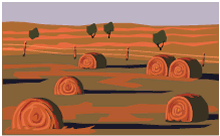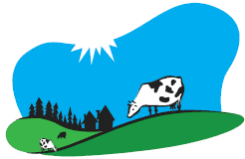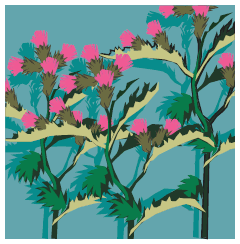

To send a message to an author, click on the author's name at the end of the article.
This Month in Ag Connection | Ag Connection - Other Issues Online
Rain-delayed haymaking leads to poor-quality feed for livestock next winter. Supplemental feed will be needed to make balanced rations. A hay test makes the first step in learning how much supplement will be needed.

For best quality, hay should be harvested in May before plants set seed. When seed heads fill, sugars and proteins move from leaves into the seeds. High fiber remains instead of nutrients needed for high-quality hay. However, this May did not give farmers many rain-free days to cut, cure and bale hay. Rainfall extended into June, further lowering odds for making good hay.
More hay than usual was cut in July. Not a good sign. However, the regrowth has a chance to make higher-quality feed. Unfortunately, cool-season grasses go into summer slump, growing little in July and August. Regrowth may not come until fall rains return. Applying nitrogen fertilizer in mid- to late August can boost yield and quality of fall growth.
Rather than making fall hay, University of Missouri Extension forage specialist Rob Kallenbach recommends stockpiling fall grass growth for strip grazing. Stockpiled pastures can be grazed well into winter.
One extension specialist reported that producers who didn't cut hay in the spring want to delay cutting hay until fall. They believe the forage will gain nutrients from regrowth. Don't do that. Over time, mature standing grass leaves rot and dry rather than gain quality.
There's an extra hazard in that over-mature hay. Ergot alkaloids may be contained in the seed heads. That further lowers quality. Start with a clean field to allow better-quality forage to grow.
Last year's drought allowed making higher-quality hay than this year. The spring of 2012 was wet enough to grow hay. Then it was dry enough that hay could be harvested without rain damage.
Testing hay now will aid in making balanced rations for winter feeding.
Details on taking hay samples and on testing labs can be obtained from local MU Extension office.
Source: Robert Kallenbach, State Forage Specialist
This Month in Ag Connection | Ag Connection - Other Issues Online

This Month in Ag Connection | Ag Connection - Other Issues Online
Forage management strategies are as varied as the people that grow the forages. Most farmers in Missouri have been producing forages for a number of years and have a pretty good idea of what they want to do and when they want to do it. These ideas may be completely different from the ideas of a farmer that lives just down the road. Despite these different management strategies, there are a few key concepts to remember as fall approaches:


Even the best-managed forage fields will decline over time. Once the desired forage makes up less than 50 percent of a field, it is time to consider a complete pasture renovation. The University of Missouri recommends the "spray-smother-spray" method, especially when trying to eliminate KY31endophyteinfected tall fescue. Spray-smother-spray consists of spraying the entire pasture with glyphosate, planting a winter annual grain crop such as wheat, and then spraying the cover crop with glyphosate and seeding a new forage in the spring. Some novel-endophyte, nontoxic tall fescue varieties to consider Jesup MaxQr, ArkShield, Texoma MaxQII, DuraMax Armor, and Bar Optmia Plus E34. Converting as few as 25 percent of pasture acres to novel endophyte tall fescue and grazing those renovated acres during the breeding season improved conception rates of spring calving cows in a University of Arkansas study. Following the above concepts will delay the need for pasture renovation and will result in the greatest utilization of forages.
Source: Travis Harper, Agronomy Specialist
This Month in Ag Connection | Ag Connection - Other Issues Online
After the last drought, thistles have taken advantage of weakened grass stands and rosettes to full-bloomed plants are visible in many fields through the area.
There are several species of thistle that can invade a field. Three of these species are on the Missouri noxious weeds list - Canadian, musk and scotch thistle. If a plant is listed as a noxious weed, control measures are required by law.

Most thistles, including musk and scotch, are biennials which mean they have a two year lifecycle and seeds, which may have survived in the soil many years, have the opportunity to germinate when forage stands thin due to overgrazing or drought damage.
Unlike musk or scotch thistle, the Canadian thistle is a perennial plant with a rhizomatous root system allowing it to spread by either seed or by multiplication of the roots.
Thistle seeds usually germinate and form rosettes in the spring or fall, but can also germinate during the summer months when ample moisture is present.
Spraying an herbicide to control thistles is most effective when applied during the rosette (vegetative) stage of growth.
Thistle rosettes can be easily overlooked by busy producers during the late fall and spring. Sometimes you don't realize you have a problem until you see the thistles bolting and beginning to flower during the summer month.
Once the thistles have bolted and flowering begins, chemical control methods become less effective and a higher rate of herbicide is needed. Applications of GrazonNext, Remedy/Martin's Clear Pasture (triclopyr), Grazon P+D/Gunslinger/Trooper P+D, or premixes of products containing triclopyr or dicamba and mixed with 2,4-D can give producers up to 70% control during flowering.
Brush hogging musk thistles within two days after the terminal flower head has bloomed can be an effective control method and prevent rebolting for this species. Other species of thistle may rebolt after initial cutting and to significantly increase control, brush hogging should be repeated about three weeks later. Controlling Canadian thistle using only a brush hog will require repeated cuttings per season for several years.

In order to reduce seed production, producers should brush hog when the flower buds begin to turn pink or purple. Approximately seven days after buds begin to turn pink or purple, blooms will develop viable seeds. Brush hogging after the seven-day window may actually spread live seed.
There are insects that feed on thistle rosettes and the buds. Prior to brush hogging or spraying, look for feeding damage on the rosettes or cut flowers open to scout for weevil that may be actively feeding on the seeds. For most successful control, six to eight head weevils are needed per flower.
Whether mature thistle are sprayed, brush hogged or if weevils are allowed to take charge on controlling thistle populations, scouting later this summer and into the fall will give producers a head start on controlling next year's crop of thistles with fall or spring herbicide applications if they find more rosettes.
For more information regarding thistle control or for help identifying the species of thistle, please contact your local MU Extension agronomist.
Source: Brie Menjoulet, Agronomy Specialist
This Month in Ag Connection | Ag Connection - Other Issues Online
Publishing Information
Ag Connection is published monthly for Northeast and Central areas of Missouri producers and is supported by the University of Missouri Extension, the Missouri Agricultural Experiment Station, and the MU College of Agriculture, Food and Natural Resources. Managing Editor: Mary Sobba.